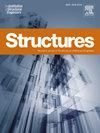Machine learning approach in the quantitative evaluation of the seismic behaviour for 3D reinforced concrete frame structures
IF 4.3
2区 工程技术
Q1 ENGINEERING, CIVIL
引用次数: 0
Abstract
The implementation of performance-based seismic design (PBSD) in the design and optimization of the structural system of buildings becomes paramount in view of recent seismic design codes. The large number of simulations and analyses to be conducted for specific types of structures and specific seismic areas are prerequisites of the PBSD methodology. The application of machine learning (ML) techniques proved effective for the development of prediction models that have the potential to significantly minimize the amount of time required for structural damage assessment. Artificial neural networks (ANNs) demonstrated the ability to generalize by accurately predicting output parameters for unseen input parameters not included in the training dataset. In this research, an ANN was used for predicting structural damage parameters corresponding to 3D reinforced concrete frame structure subjected to seismic scenarios and for evaluating the influence of various seismic actions on the structures. A total of 243 3D-reinforced concrete models were generated and subjected to 14 seismic scenarios. Thus, 3402 input-output data sets were obtained and were used for ANN training (80 %) and validation (20 %). A total of 10 input parameters were considered to influence the seismic behaviour and damage levels in the RC frame structures. Out of the 6 input structural parameters, the number of stories, the span width and the width of the column cross-section have the highest impact on the seismic damage of reinforced frame structures. From the 4 input parameters characterizing the seismic motion, the peak ground velocity (PGV) and peak ground acceleration (PGA), were found to be the most important seismic parameters which influenced the damage of the analysed structures. The performance of the ANN was compared against two other machine learning algorithms commonly used in civil engineering applications: Random Forest (RF) and Extreme Gradient Boosting (XGBoost). While these algorithms performed marginally better than ANN in the training and validation stages, they did not manage to be accurate in the testing phase when using newly generated data sets. The considered output parameters were: fundamental period of vibration for the non-damaged and damaged states, final softening index, interstory drift ratio, maximum displacements and maximum absolute accelerations. The ANN was able to accurately predict all output parameters (correlation coefficient larger than 0.85) with the exception of final softening index that may be influence by more complex phenomena that are beyond the scope of this paper. The proposed ANN-based prediction model proves to be a fast and reliable tool for quickly assessing the damage state of 3D reinforced concrete frame structures subjected to different seismic scenarios. It can be further enhanced and extended to include other parameters not considered at this stage of research as well as being included in stacked ML algorithms.
三维钢筋混凝土框架结构抗震性能定量评价中的机器学习方法
基于性能的抗震设计(PBSD)在建筑结构体系的设计和优化中变得至关重要。对特定类型的结构和特定震区进行大量的模拟和分析是PBSD方法的先决条件。事实证明,机器学习(ML)技术的应用对于开发预测模型是有效的,这些模型有可能大大减少结构损伤评估所需的时间。人工神经网络(ann)通过准确预测未包含在训练数据集中的未知输入参数的输出参数,证明了其泛化能力。本研究采用人工神经网络预测三维钢筋混凝土框架结构在地震情景下的结构损伤参数,并评估各种地震作用对结构的影响。总共生成了243个3d钢筋混凝土模型,并经受了14种地震情景。因此,获得了3402个输入输出数据集,用于人工神经网络的训练(80 %)和验证(20 %)。总共考虑了10个影响钢筋混凝土框架结构抗震性能和损伤水平的输入参数。在6个输入结构参数中,层数、跨距宽度和柱截面宽度对钢筋框架结构的震害影响最大。从表征地震运动的4个输入参数中,发现峰值地速度(PGV)和峰值地加速度(PGA)是影响所分析结构损伤的最重要的地震参数。将人工神经网络的性能与土木工程应用中常用的另外两种机器学习算法进行了比较:随机森林(RF)和极端梯度增强(XGBoost)。虽然这些算法在训练和验证阶段的表现略好于人工神经网络,但在使用新生成的数据集的测试阶段,它们并没有做到准确。考虑的输出参数为:未损伤和损伤状态下的基本振动周期、最终软化指数、层间漂移比、最大位移和最大绝对加速度。人工神经网络能够准确预测除最终软化指数外的所有输出参数(相关系数大于0.85),最终软化指数可能受到更复杂现象的影响,超出了本文的范围。基于人工神经网络的三维钢筋混凝土框架结构损伤预测模型是一种快速、可靠的工具,可以快速评估不同地震场景下三维钢筋混凝土框架结构的损伤状态。它可以进一步增强和扩展,包括在这个研究阶段未考虑的其他参数,以及包括在堆叠ML算法中。
本文章由计算机程序翻译,如有差异,请以英文原文为准。
求助全文
约1分钟内获得全文
求助全文
来源期刊

Structures
Engineering-Architecture
CiteScore
5.70
自引率
17.10%
发文量
1187
期刊介绍:
Structures aims to publish internationally-leading research across the full breadth of structural engineering. Papers for Structures are particularly welcome in which high-quality research will benefit from wide readership of academics and practitioners such that not only high citation rates but also tangible industrial-related pathways to impact are achieved.
 求助内容:
求助内容: 应助结果提醒方式:
应助结果提醒方式:


